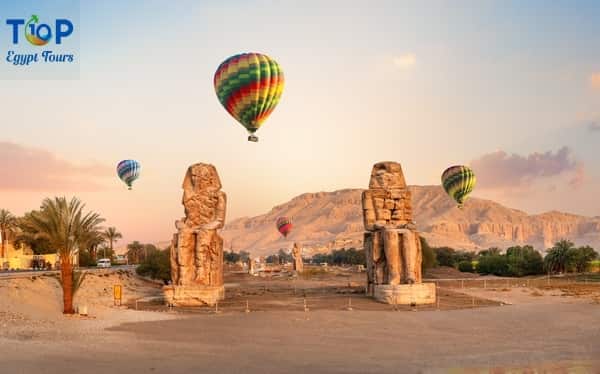Nestled in the heart of ancient Thebes, now known as Luxor, stand two colossal statues that have stood the test of time. These towering giants, known as the Colossi of Memnon, have been guardians of Thebes for over 3,400 years.
The Colossi of Memnon are two massive stone statues, each weighing over 700 tons and standing at a height of 18 meters (60 feet). They depict Pharaoh Amenhotep III, who ruled Egypt during the 18th dynasty around 1390 BCE. The statues were carved from a single block of quartzite sandstone and were originally part of a grand temple complex dedicated to the sun god Aten.
The Colossi of Memnon were named after the Greek poet Memnon, who was said to have been buried near the statues during Alexander the Great’s conquest of Egypt. The Greeks believed that the statues emitted a melodious sound at dawn, which they attributed to Memnon’s spirit. This legend has been debunked by modern science, as it is now known that the sound was actually caused by a crack in one of the statues that amplified the noise from nearby construction.
Despite their impressive size and historical significance, the Colossi of Memnon have faced numerous challenges over the centuries. During ancient times, they were damaged by invading armies and natural disasters such as earthquakes. In more recent times, they were nearly destroyed by British archaeologist Howard Carter during his excavation of nearby tombs. Carter mistakenly believed that the statues were blocking his path and ordered his workers to remove them. Fortunately, his superiors intervened and prevented further damage.
Today, the Colossi of Memnon are a major tourist attraction and are considered one of Egypt’s most iconic landmarks. They are part of the UNESCO World Heritage Site known as Karnak Temple Complex, which includes several other ancient temples and monuments in Luxor. Visitors can marvel at their size and beauty while learning about their rich history and cultural significance.
In conclusion, the Colossi of Memnon are more than just impressive statues; they are symbols of ancient Egyptian civilization and its enduring legacy. They serve as a reminder of a time when pharaohs ruled Egypt and gods walked among mortals. As we continue to learn about these magnificent structures, we gain a deeper appreciation for the artistry and engineering skills of our ancestors. May these guardians continue to stand tall for generations to come, reminding us all of our shared heritage and inspiring us to preserve it for future generations.



Comment (0)